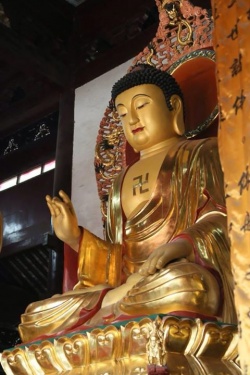The Differences between Mahamudra and Dzogchen
Whether on the gross, subtle, or subtlest clear light level, the nature of mental activity remains the same. Mahamudra (phyag-chen, great seal) practice, found in the Kagyu, Sakya, and Gelug/Kagyu traditions, focuses on this nature. The Kagyu and Gelug/Kagyu traditions have both sutra and anuttarayoga tantra levels of the practice, while Sakya only an anuttarayoga one. In other words, Sakya mahamudra focuses only on the nature of clear light mental activity, while the other two traditions include focus on the nature of the other levels of mental activity as well.
Rigpa shares the same nature as the three levels of mental activity analyzed by the non-dzogchen schools. Dzogchen practice, however, is exclusively done on the highest level of tantra and deals only with the subtlest level of mental activity. Moreover, dzogchen does not focus merely on the conventional and deepest natures of rigpa, but also on its various aspects and facets.
The Differences between Rigpa and Clear Light
Further, rigpa is not an exact equivalent of clear light. Rather, it is a subdivision of it.
Different Degrees of Being Unstained
The clear light level of mind is naturally devoid of grosser levels of mental activity, which are the levels at which conceptual cognition and the fleeting stains of disturbing emotions and attitudes occur. Before enlightenment, however, clear light mental activity is not devoid of the habits of grasping for true existence, which may be imputed or labeled on it. Nevertheless, when clear light is manifest, these habits do not cause clear light activity to make discordant (dual) appearances of true existence (gnyis-snang), nor do they prevent it from cognizing the two truths simultaneously (appearances and voidness), which they do when grosser levels of mind are active.
Rigpa, on the other hand, is devoid of even the habits of grasping for true existence. It is the totally unstained natural state of the mind.
This could explain for the difference in views and and also to me it explains for the criticism of Mahamudra system by other schools too.
Dzogchen Explains from the Point of View of the Result
According to the early twentieth-century Rimey (nonsectarian) master Jamyang-kyentzey-wangpo (‘ Jam-dbyangs mkhyen-brtse dbang-po), the four traditions of Tibetan Buddhism may be differentiated according to the point of view from which they explain: basis, path, or result.
The Gelug tradition explains from the point of view of the basis – in other words, from the viewpoint of ordinary practitioners. For example, such persons are capable of perceiving appearances or voidness only separately, although the two are inseparable. Therefore, Gelug explains appearances and voidness as the two truths and thus deepest truth is self-voidness alone. Consequently, Gelug presents the svabhavakaya (ngo-bo-nyid sku, body of self-nature) of a Buddha as the voidness of a Buddha’s omniscient awareness.
The Sakya tradition explains from the viewpoint of the path. Although clear light mental activity on the basis level, for example at the moment of death, cannot be said to be blissful; nevertheless, it is made blissful on the anuttarayoga tantra path. Speaking from that point of view, Sakya asserts clear light awareness as naturally blissful.
Nyingma and Kagyu traditions explain from the resultant point of view of a Buddha. For example, Buddhas nonconceptually cognize appearances and voidness simultaneously. Therefore, Nyingma and Kagyu – and thus dzogchen – explain deepest truth as inseparable voidness and appearance and, consequently, they present svabhavakaya as the inseparability of the other three Buddha-bodies.
